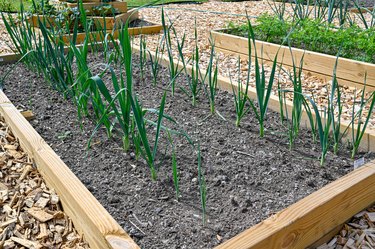
Many people are happy to use potting soil and trust that everything in the bag belongs there. Others, however, may be suspicious of the little yellow balls in the plant soil. What are they, and are they supposed to be there? Has this bag of potting soil been contaminated by insect eggs, or is there some mysterious chemical mixed in?
Small Yellow Beads in Soil
Video of the Day
Most of the time, these beads are not only harmless but desirable. These are slow-release fertilizers that are incorporated in commercially sold potting soil to improve its effectiveness. The color of the balls can indicate which kind or compound of fertilizer they contain. Osmocote is identified as small granules of yellowish-brown, and they contain a mixture of potassium sulfate and ammonium nitrate that encourage healthy plant growth. Osmocote can last up to five months in the soil before being depleted.
Video of the Day
Nutricote-type fertilizers, in contrast, are small gray spheres that can last up to an entire year in the soil, exuding nutrients the whole time.
So, all those little yellow balls in plant soil are fertilizer beads, right? Actually, this is not always true. Snails, gnats and worms are known to crawl into the small holes in soil bags and lay eggs there. Although the chances are low, you can do a few things to discern fertilizer pellets from insect eggs.
Insect Eggs vs. Fertilizer Pellets
While those small yellow spheres in potting soil are almost always slow-release fertilizer pellets, there is a chance that the small yellow balls (or white balls) found in plant soil can be the eggs of harmful insects. Snail eggs are white and mostly round and can be identified by their slightly pointed end, which makes them an imperfect sphere. Worm eggs are elongated, and ant eggs are bean-shaped. However, while pearlite can sometimes resemble ant eggs, it is harmless and is included in potting soil to improve drainage.
One litmus test you can use is temperature-based. Fertilizer pellets dissolve quicker in warm temperatures. Osmocote-style pellets sometimes dissolve in as few as four days at temperatures above 70 degrees Fahrenheit. If you have observed the soil at higher temperatures for at least a week and the small spheres aren't disappearing, you may have gotten a bag with insect eggs mixed in. Despite the manufacturers' best efforts, some bugs will find their way inside since the bags need to have holes in them to prevent mold from building up inside.
Best Slow-Release Fertilizer Granules
Fertilizer balls in potting soil can have various chemical compositions. Granular fertilizers will generally be distinguished by their NPK ratio. NPK stands for nitrogen, phosphorus and potassium, as represented by their elemental symbols.
Fertilizer ratios can be balanced for an all-rounded fertilizer or skewed toward higher nitrogen in lawn fertilizers and higher phosphorus in vegetable and fruit garden fertilizers. Which is best for your plants depends on where you're applying it and the point in the growing season.
Be aware that higher temperatures cause these slow-release fertilizers to break down quicker, which can lead to a sudden spike in the nutrients that are being released into the soil. While this might sound like a good thing, too much of any nutrient can chemically burn your plants or inhibit the absorption of other nutrients. Carefully read the labels and application instructions for any fertilizers before using them.